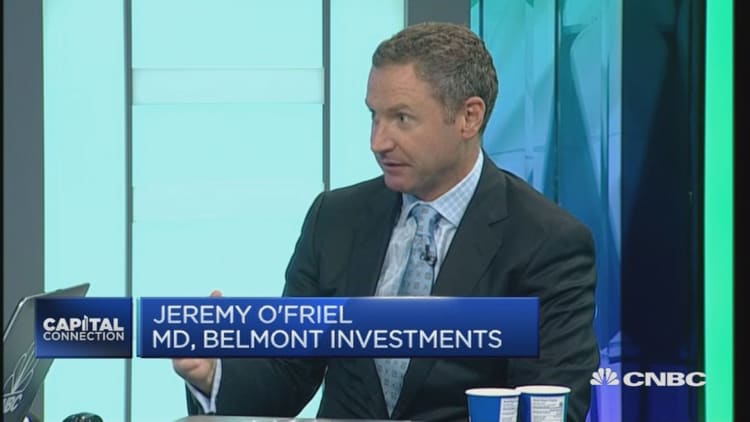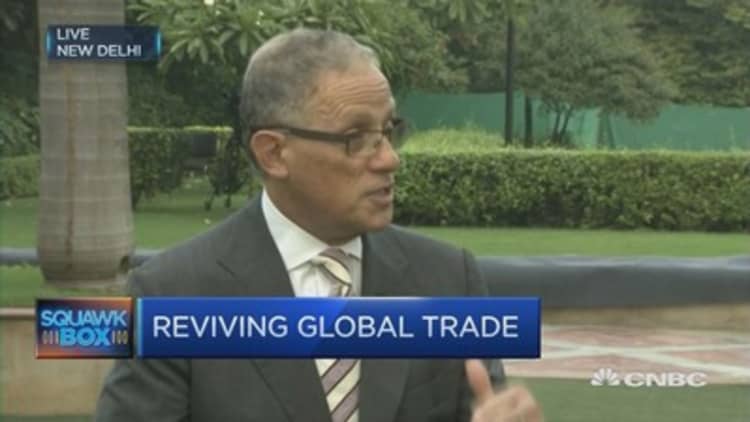America's key inflation indicators are pointing up, but their staying power is weak. The pillars to aggregate demand are too frail to support a rebound of economic activity that could cause accelerating cost and price pressures in the months ahead.
To see that, below is a quick review of key variables driving monetary policy decisions.
Let's start with inflation because that is a monetary phenomenon. Consequently, price stability, usually defined as an inflation rate of 0-2 percent, is the main intermediate policy target pursued by monetary authorities.
Here is what we've got in the U.S. at the moment. Consumer prices less food and energy (aka core CPI) have been pushing above annual rates of 2 percent since November of last year. Two months ago, that measure of price inflation shot up to 2.3 percent.
Of particular importance are rising price pressures in the service sector, which accounts for about 90 percent of the U.S. economy. Service prices increased in August by 3.2 percent, with costs in the medical, housing and transportation sectors rising at annual rates of 5.1 percent, 3.4 percent and 3.1 percent, respectively.
Focus on jobs and incomes
These price trends have been foreshadowed by increases in unit labor costs (difference between hourly compensation and labor productivity). Over the last two years, the costs of labor, which usually put the floor below the general price-inflation trends, were rising at annual rates of 2 percent. They accelerated to 2.5 percent in the first half of this year, mainly because productivity growth collapsed.
The question now is: How likely is it that these rising cost and price pressures will continue?
The answer lies in the strength of aggregate demand we can expect in the months ahead. As always, the two variables to watch there are jobs and household incomes because they directly drive three-quarters of the U.S. economy.
Labor markets have improved considerably, but serious problems remain. Employment growth in the year to September rose 2 percent, while the headline unemployment number - 7.9 million – over that period was roughly stable. Also, little change during that interval was noted with regard to 5.9 million of involuntary part-time workers (people working part-time because they cannot find full-time jobs) and 1.8 million people dropping out of the labor force because they are unable to find a job.

The effective unemployment rate, therefore, is double the officially reported 5 percent, because there are 15.6 million people out of work or without stable employment.
That considerable slack in labor markets was partly reflected in a sharply slowing income growth. In the first two quarters of this year, inflation adjusted after-tax incomes increased at an annual rate of 2.9 percent, a large drop from a 3.8 percent gain observed during the same period of last year.
This picture of jobs and incomes does not suggest that one can expect a soaring growth of household consumption and residential investments (72 percent of GDP) in the coming months.
Insist on fair trade
And neither is it likely that non-residential capital outlays will stage an impressive rebound from a 0.5 percent decline in the first two quarters of this year. After a sharp drop of the capacity utilization rate in August, the industrial sector is currently operating nearly 5 percentage points below its long-term average of 80 percent. The latest survey data are confirming that. Supplier deliveries, for example, are stable in both manufacturing and service sectors because rising orders and output volumes can be readily accommodated from existing production capacities.
Can we expect that foreign trade (about one-third of GDP) will provide a net stimulus to investments and consumer expenditures?
Well, that would be the world we have not seen in decades. In the first eight months of this year, we ran a trade deficit of nearly $500 billion. On current trends, we shall probably end up with a trade gap of $750 billion by the end of this year. And that will clip close to an entire percentage point from the growth of our domestic demand.

Again, we are being taken to cleaners by our trade partners in Europe and East Asia (a brave fellow New Yorker even said that they were "eating our lunch"). But it is not politically correct to say – let alone do – anything about the need to rebalance our trade accounts in accordance with the rules of international trade adjustment. Our internationalists sound like it would not be "polite" to bring that up as a key G-20 issue.
You have now all the necessary information to form a view with respect to the likelihood of sustained upward cost and price pressures in the U.S. over the coming months. You can, therefore, try to have your own answer as to whether the Fed should now be rushing to initiate a process of rate hikes.
My own view is that – on present evidence - there is no need for the Fed to rush. And I am glad to see that my former colleagues seem to share that assessment. You can see that too, because the Fed's balance sheet shows a relatively stable level of the high-powered money, with a significant loosening of interbank credit conditions since the end of last month.
Never mind that the tightening bond market does not seem to notice, to say nothing of ill-informed short sellers. They'll come around.
Another interesting – and encouraging – signal is that banks are now responding better to credit demand. Bank lending to consumers (40 percent of the total consumer credit), for example, was growing in July (the last data point available) at an annual rate of more than 7 percent. In recent months, banks have also started to overtake nonbank lending by a widening margin, which means that the Fed can now have a better monitoring of banks' consumer lending operations.
If you want to see how significant all that is, you can think of euro area's bank lending to households barely eking out an annual increase of 1.8 percent in August.
Investment thoughts
I believe that the key underpinnings to demand in U.S. labor and product markets are not sufficiently strong to support accelerating costs and prices in the months ahead.
America's growing trade deficits will also be a significant depressant to domestic demand as our import-competing industries continue to struggle with their shrinking market shares.
The Fed, therefore, does not have to rush into credit tightening policies.
I maintain my earlier view that any major changes to credit conditions should be coordinated with fiscal, foreign trade and structural policies of the incoming legislative and executive authorities.
We have to rapidly raise the economy's (non-inflationary) growth potential to 3 percent from an unacceptably low 1.7 percent at present. The economy, infrastructure, education and healthcare should be the main national priorities. Indeed, it should not be difficult to understand that with our current physical limits to sustainable growth – we are going nowhere.


